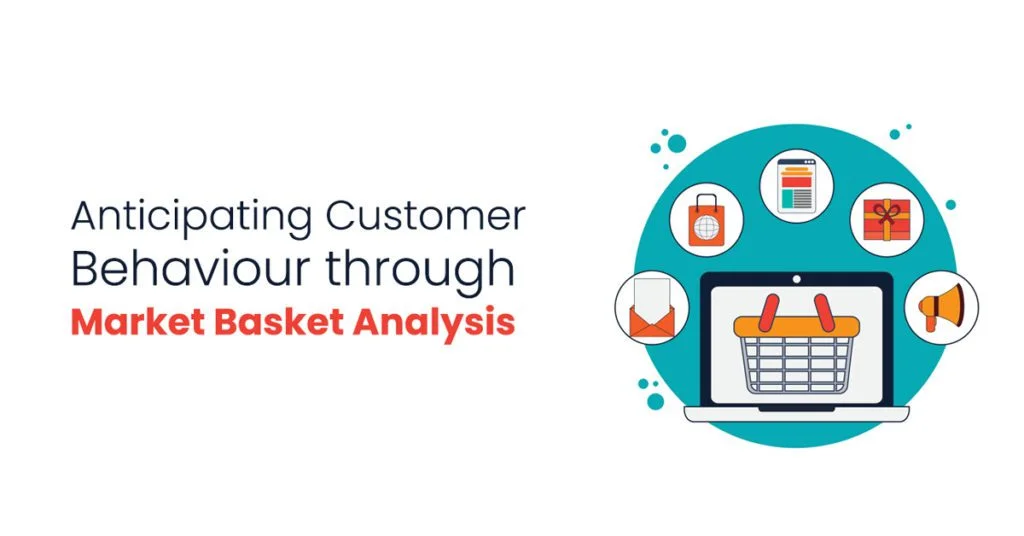Market Basket Analysis: What is it?
Market Basket Analysis is an analytical technique that provides great insights into predicting what would a customer probably purchase in the future. As one of the most widely used concepts in Retail business, MBA helps boost sales, analyze sales patterns of any product, customer purchase patterns via online browsing behaviour or existing sales records. To sum it up, market basket analysis promotes marketing effectiveness and increases opportunities for up-sell and cross-sell.
How our clients have leveraged Market Basket Analysis is- by understanding what would be the next product the customer would be more likely to buy, what product should be suggested to the customer depending on the “attached” products history and how does the store layout play a role in the sale of “attached” products. Attached products or associated products are the ones a customer is highly likely to buy together.
Theory of Market Basket Analysis:
The idea of an MBA is simple- the customers who buy a certain product or group of products, are more likely to buy another product or group of products. For example: If somebody at a store buys chocolates and cookies most of the time, they are highly likely to buy a Coke than somebody who did not buy cookies.
With the use of huge transactional data, the MBA helps in identifying the “keystone products”. These products are more likely to impact the business either due to higher retail price or unavailability.
For a quick example, at a store level- Gourmet is the most on-the-go bought product. Their appeal may be limited, but the bucket of attracted customers and their impulsive purchase of Gourmet products is very much dependent on the high-visibility placement in the stores.
The Association Rule of Market Basket Analysis
As already mentioned, the MBA finds relationships and discovers patterns across the purchase of the products. The relationship can be identified as a shorthand notation of the conditional rule as below:
{Xi } =Antecedent → {Yi }= Consequent
This can be read as: IF {Cookies, Chocolates} THEN {Coke}
The items purchased by the customer are collectively referred to as itemset.
The set of items on the left is called the Antecedent of the rule.
The set of items on the right is called the Consequent of the rule.
The probability of the occurrence of the Antecedent is called the support of the rule, which is the relative frequency of the itemset appearing in the transaction together.
For a retail store with the major business in Men’s Apparel, the purchase combination of “Tailored Shirts” and “Tailored Trousers” would have high support and they can be priced at a Markdown value or a combo offer accordingly to attract people to the stores. According to the market basket analysis, the customer will be more likely to buy a Tie or a Belt with the aforementioned antecedent.
The probability of the customer buying a Tie/Belt as the consequent is called the confidence of the rule. Placing high margin items near high confidence items can prove to increase the overall margin of purchase.
Let’s talk about the “lift” of the rule:
The ratio of the Antecedent co-occurring with Consequent, divided by the probability of antecedent and consequent occurring independently is known as the “lift of the rule”.
The value of lift >1 indicates that the occurrence of antecedent increases the chances of the occurrence of consequent in a given transaction.
The value of lift <1 indicates that the purchase of antecedent reduces the chances of that of the consequent. This is the case where the products are alternatives to each other.
The value of lift =1 indicates zero dependencies of the occurrence of consequence on that of the antecedent.
Applications of Market Basket Analysis
Market Basket Analysis helps retail business augment the below through the generated insights:
>Store Layout: Placing the products with high affinity together in the stores can boost sales.
>Inventory Optimization: As per the customer purchase patterns and most probable products to be purchased, maintaining optimal stocks in the inventory becomes efficient.
>Product Recommendation: Products can be recommended as per the lift value to the customers.
>Targeted Marketing: Association rules and its results can be leveraged to increase customer spends.
>Ad Optimization: Analyzing customer’s response patterns from various ad sources or media, retailers can implement predictable advertising strategies.
Market Basket Analysis with its applications outside the Retail sector adds up to its crucial importance:
Manufacturing: predictive analysis of gadgetry failure.
Pharmaceutical: co-occurring association between diagnosis and drug ingredients prescribed to different patient groups.
Finance: fraud detection as per credit card usage details.
Any sector with data to analyze the purchase trend fluctuations as per demographics or socio-economic data.
A Fun Fact:
In 1992, a team at a US Based Retailer discovered the impossible yet high correlation between the products: Diaper and beer!
Ever since then, various analytics industries tried to establish the same pattern of purchase across the rest of the 1990s. IBM even aired a documentary using the example of Diapers and Beer and establishing the fact that cross-selling has no baseline and the correlation is a representation of mere customer actions. To know more, read more!
About the author:
Charu Priyadarshini loves to see the world from an edge- as she believes every coin has three sides-” the heads, the tail, the edge”. Besides her love for analytics and writing, she has a deep-rooted interest in Bharatnatyam, Kick-boxing and Hiking.










